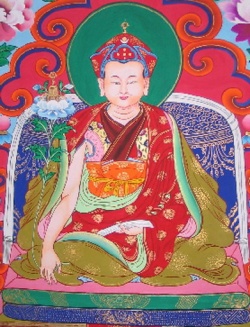The 59 Slogans of Lojong
Lojong was originally brought to Tibet by an Indian Buddhist teacher named Atisha. It is a mind training practice in the Tibetan Buddhist tradition and is based on a set of aphorisms formulated in Tibet in the 12th century by Geshe Chekhawa. The practice involves refining and purifying one’s motivations and attitudes.
The 59 proverbs that form the root text of the mind training practice are designed as a set of antidotes to undesired mental habits that cause suffering.
Point One: The preliminaries, which are the basis for dharma practice
Slogan 1. First, train in the preliminaries; The Four Reminders or alternatively called The Four Thoughts
1. Maintain an awareness of the preciousness of human life.
2. Be aware of the reality that life ends; death comes for everyone; Impermanence.
3. Recall that whatever you do, whether virtuous or not, has a result; Karma.
4. Contemplate that as long as you are too focused on self-importance and too caught up in thinking about how you are good or bad, you will experience suffering. Obsessing about getting what you want and avoiding what you don’t want does not result in happiness; Ego.
Point Two: The main practice, which is training in bodhicitta.
Absolute Bodhicitta
Slogan 2. Regard all dharma as dreams; although experiences may seem solid, they are passing memories.
Slogan 3. Examine the nature of unborn awareness.
Slogan 4. Self-liberate even the antidote.
Slogan 5. Rest in the nature of alaya, the essence, the present moment.
Slogan 6. In postmeditation, be a child of illusion.
[[Relative [Bodhicitta]]
Slogan 7. Sending and taking should be practiced alternately. These two should ride the breath (aka. Practice Tonglen).
Slogan 8. Three objects, Three Poisons, Three Roots of Virtue
The Three Objects are friends, enemies and neutrals. The Three Poisons are craving, aversion and indifference. The Three Roots of Virtue are the remedies.
Slogan 9. In all activities, train with slogans.
Slogan 10. Begin the sequence of sending and taking with yourself.
Point Three: Transformation of Bad Circumstances into the Way of Enlightenment
Slogan 11. When the world is filled with evil, transform all mishaps into the path of bodhi.
Slogan 12. Drive all blames into one.
Slogan 13. Be grateful to everyone.
Slogan 14. Seeing confusion as The Four Kayas is unsurpassable shunyata protection.
The Four Kayas are Dharmakaya, Sambhogakaya, Nirmanakaya, Svabhavikakaya. Thoughts have no birthplace, thoughts are unceasing, thoughts are not solid, and these three characteristics are interconnected. Shunyata can be described as “complete openness.”
Slogan 15. The Four practices are the best of methods.
The Four Practices are: accumulating merit, laying down evil deeds, offering to the dons, and offering to the dharmapalas.
Slogan 16. Whatever you meet unexpectedly, join with meditation.
Point Four: Showing the Utilization of Practice in One’s Whole Life
Slogan 17. Practice The Five Strengths, the condensed heart instructions.
The Five Strengths are: strong determination, familiarization, the positive seed, reproach, and aspiration
Slogan 18. The Mahayana instruction for ejection of consciousness at death is The Five Strengths: how you conduct yourself is important. When you are dying practice The Five Strengths.
Point Five: Evaluation of Mind Training
Slogan 19. All dharma agrees at one point — All Buddhist teachings are about lessening the ego, lessening one’s self-absorption.
Slogan 20. Of the two witnesses, hold the principal one — You know yourself better than anyone else knows you
Slogan 21. Always maintain only a joyful mind.
Slogan 22. If you can practice even when distracted, you are well trained.
Point Six: Disciplines of Mind Training
Slogan 23. Always abide by The Three Basic Principles — Dedication to your practice, refraining from outrageous conduct, developing patience.
Slogan 24. Change your attitude, but remain natural.– Reduce ego clinging, but be yourself.
Slogan 25. Don’t talk about injured limbs — Don’t take pleasure contemplating others defects.
Slogan 26. Don’t ponder others — Don’t take pleasure contemplating others weaknesses.
Slogan 27. Work with the greatest defilements first — Work with your greatest obstacles first.
Slogan 28. Abandon any hope of fruition — Don’t get caught up in how you will be in the future, stay in the present moment.
Slogan 29. Abandon poisonous food.
Slogan 30. Don’t be so predictable — Don’t hold grudges.
Slogan 31. Don’t malign others.
Slogan 32. Don’t wait in ambush — Don’t wait for others weaknesses to show to attack them.
Slogan 33. Don’t bring things to a painful point — Don’t humiliate others.
Slogan 34. Don’t transfer the ox’s load to the cow — Take responsibility for yourself.
Slogan 35. Don’t try to be the fastest — Don’t compete with others.
Slogan 36. Don’t act with a twist — Do good deeds without scheming about benefiting yourself.
Slogan 37. Don’t turn gods into demons — Don’t use these slogans or your spirituality to increase your self-absorption
Slogan 38. Don’t seek others’ pain as the limbs of your own happiness.
Point Seven: Guidelines of Mind Training
Slogan 39. All activities should be done with one intention.
Slogan 40. Correct all wrongs with one intention.
Slogan 41. Two activities: one at the beginning, one at the end.
Slogan 42. Whichever of the two occurs, be patient.
Slogan 43. Observe these two, even at the risk of your life.
Slogan 44. Train in The Three Difficulties.
Slogan 45. Take on The Three Principal Causes: the teacher, the dharma, the sangha.
Slogan 46. Pay heed that The Three Never Wane: gratitude towards one’s teacher, appreciation of the dharma (teachings) and correct conduct.
Slogan 47. Keep the three inseparable: body, speech, and mind.
Slogan 48. Train without bias in all areas. It is crucial always to do this pervasively and wholeheartedly.
Slogan 49. Always meditate on whatever provokes resentment.
Slogan 50. Don’t be swayed by external circumstances.
Slogan 51. This time, practice the main points: others before self, dharma, and awakening compassion.
Slogan 52. Don’t misinterpret.
The 6 thing you may misinterpret are patience, yearning, excitement, compassion, priorities and joy. Your patient when you’ll get your way, but not when its difficult. You yearn for worldly things, instead of an open heart and mind. You get excited about wealth and entertainment, instead of your potential for enlightenment. You have compassion for those you like, but none for those you don’t. Worldly gain is your priority rather than cultivating loving-kindness and compassion. You feel joy when you enemies suffer, and do not rejoice in others’ good fortune.
Slogan 53. Don’t vacillate (in your practice of Lojong).
Slogan 54. Train wholeheartedly.
Slogan 55. Liberate yourself by examining and analyzing: Know your own mind with honesty and fearlessness.
Slogan 56. Don’t wallow in self-pity.
Slogan 57. Don’t be jealous.
Slogan 58. Don’t be frivolous.
Slogan 59. Don’t expect applause.
Source
https://thebuddhafultao.wordpress.com/2012/07/04/the-59-slogans-of-lojong/








